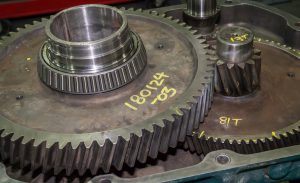Know Your Gearbox.
Your car engine runs at lightning speed. The car gearbox is the heart of your car which turns the power on from your engine and makes you go from one point to another. It allows your car to transfer this power to your wheels. Gearbox issues should be treated early or else it will surprise you with more threats. Fundamental design issues, manufacturing defects, deficiencies in the lubricant, excessive time at a standstill, and high loading are the root causes of gearbox failure.
Main Causes of Gearbox Failure
Frosting
The frosting is the formation of micro-pits on a gear’s surface. When the lubricating film breaks down due to heat, this problem occurs. Frosting can be avoided by performing regular inspections, maintenance, and temperature checks.
Corrosion
Corrosive wear is a sort of chemical breakdown that can lead to the failure of gears. When lubricants degrade, the chemical residue left behind eats away the metal in gears, causing corrosion. Corrosive wear usually appears as fine, consistent pitting over a gear’s surface. The use of modern lubricants that prevent oil from breaking down can help to prevent corrosion.
Wear and Tear
Gear failure can be caused by moderate wear due to contact patterns that favor the dedendum and addendum zones. Repeated usage of the gear causes this damage, which is almost unavoidable. By maintaining your gearbox adequately oiled, you can limit the damage caused by moderate wear and tear. It’s also a good idea to schedule regular checks to spot potential contact damage early. Contamination of the lubricant might also cause contact patterns to differ from those intended. Make sure you use the manufacturer-recommended lubricants for your gearbox.
Abrasive damage
Contact wear is identified by radial scratch grooves and other signs caused by abrasive wear. When the lubrication is polluted, abrasive wear and tear occur, similar to moderate wear. Abrasions on the gear surfaces are caused by lubrication, which can result in increased noise, reduced efficiency, and potentially gearbox failure. By replenishing lubrication and keeping it clean, this type of gear damage can be avoided. To catch foreign bodies like rust and other metal particulates before they enter the gears and cause failure, you should employ a filter.
Lubrication
Lubrication is very important for gear life. The principal aspects of using lubrication are the volume of lubricant put on each gear mesh and bearing, as well as the properties of the lubricating oil. The lubricating oil forms a thin film that prevents metal-to-metal contact between the gears and within the bearing components. Modern industrial gears utilize an involute tooth structure and tooth commitment, which is a mix of rolling and sliding. The oil film is a slender hindrance between moving parts that permits the pivoting power to turn the apparatuses effectively without harming the metal surfaces.
Arrangement
Gears have a specific reaction between gear teeth and are designed to work with either parallel or right-point shafts. When a revamp is being done, the arrangement of the gears in the gearbox housing is crucial, and assessing the arrangement of the gearbox housing bores is very important. We’ve seen reducer housings get deformed or bent in mining situations when gear reducers are heavily stacked. Even a minor misalignment might result in premature gear wear and failure. The gear teeth will not mesh as they should, causing excessive weight to be placed on the weaker sections of the teeth.
Particulate contamination
This can occur as a result of filthy oil, an open filling plug, or wear or failure particles within the gearbox. The particles can not only indicate difficulties within the gearbox, but they can also increase wear and component breakdown.
Shock Loading
It is caused by rapid shock loads and occurs when a gear system is subjected to a load it was not meant to sustain. Although there is no way to predict this ahead of time, extreme caution must be exercised to avoid such disasters.
Fatigue Failure
Fatigue develops throughout time as a result of repeated loading. The application of load causes the gear tooth to bend, resulting in fatigue. Fatigues in the gear cause cracks to form at the root of the gear tooth, resulting in gear tooth failure. As a result of repetitive loading, fatigue builds over time. When a load is applied to a gear tooth, it bends, resulting in fatigue. Gear tooth failure occurs when cracks form at the base of the gear tooth due to fatigue in the gear. Micro Pitting is caused by the presence of water in the lubricant used to lubricate the gears, as well as the incorrect viscosity selection of the lubricant. Micro pitting is difficult to discover, as they appear as tiny dots on the surface of the gear tooth, and one must analyze the surface of the gear tooth to find the pitting.
We got you covered
Sheer negligence and no basic knowledge of the functioning of your automobile can get your gearbox into trouble. Carcility is the best option for people in Dubai when it comes to car maintenance. You can take your car to the best car servicing and car repair center in Dubai with just a click. Visit our website or download the Carcility App to avail special offers and packages for your car maintenance.
The post Why Do Gearboxes Fail? appeared first on Carcility.
